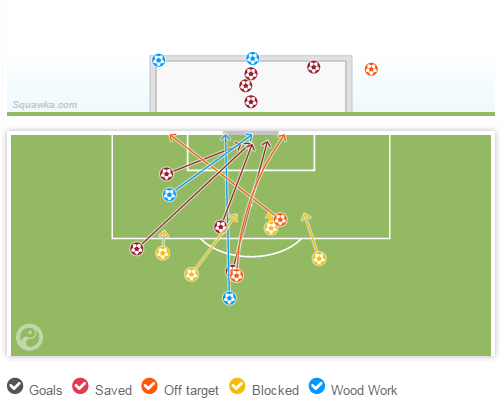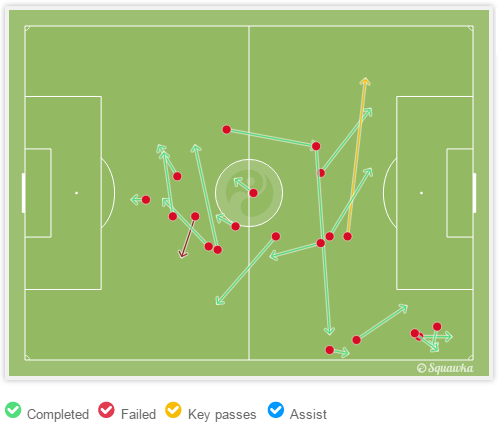Switzerland keep up with France in goalless stalemate
The encounter between Switzerland and France didn’t become an all-time classic. Instead, the match ended in a 0-0 draw that most people will remember because of ripped shirts, a busted ball and slipping players.
Line-ups
Switzerland coach Vladimir Petković decided to give Basel youngster Breel Embolo a chance, as he fielded the 19-year-old up front, leaving Haris Seferović on the bench. Other than that, compared to their previous matches, Switzerland looked identical as far as the personnel went. Petković’s 4-2-3-1 system featured the rather defensive-minded Blerim Džemaili in the number ten role, with Granit Xhaka and Valon Behrami playing behind him. Embolo was flanked by Xherdan Shaqiri and Admir Mehmedi.
 As for the tournament’s hosts, Didier Deschamps overthought the decision he made prior to their second group match, when Antoine Griezmann and Paul Pogba had to watch the game from the bench for the most part. Both superstars returned and Deschamps changed the system back into a 4-3-3. Moreover, France’s coach gave N’Golo Kanté, Blaise Matuidi, Dimitri Payet and Olivier Giroud some rest, while Yohan Cabaye, Moussa Sissoko, Kingsley Coman and André-Pierre Gignac were part of the starting eleven.
As for the tournament’s hosts, Didier Deschamps overthought the decision he made prior to their second group match, when Antoine Griezmann and Paul Pogba had to watch the game from the bench for the most part. Both superstars returned and Deschamps changed the system back into a 4-3-3. Moreover, France’s coach gave N’Golo Kanté, Blaise Matuidi, Dimitri Payet and Olivier Giroud some rest, while Yohan Cabaye, Moussa Sissoko, Kingsley Coman and André-Pierre Gignac were part of the starting eleven.
France’s approach
In a quite chaotic and wild beginning, France started out with an aggressive pressing strategy. As a result of the man-orientated scheme, they didn’t defend in their customary 4-5-1. Instead, both Swiss centre-midfielders were man-marked closely in the early build-up phase. Gignac and either Pogba or Sissoko formed the first block, while the other midfielders watched the short passing paths in the middle and towards the advancing full-backs.
Sometimes, France’s left-winger had a free role, in which he wasn’t asked to man-mark an opponent and instead waited behind Gignac to pick up balls that were captured by a near midfielder after Switzerland riskily played towards Džemaili.
The man-marking scheme, moreover, caused both full-backs to chase the opposing wingers, even when said wingers moved into deeper zones next to Xhaka and Behrami. At times, it opened up the wings, in case Switzerland’s full-backs reacted quickly enough. That said, France pressured their opponents very well and maintained a certain degree of intensity in defensive one-on-ones throughout the first half of the match. (That was probably the reason a few Swiss players had to change their shirts as they were ripped apart after a while. Probably.)
Offensively, Deschamps’ side tried to pass as many Swiss defenders as possible, as quickly as possible. Switzerland saw more of the ball because the hosts were willing to play many long balls and vertical passes towards the attacking line. Plus, France intended to complete their plays rapidly. That’s why we saw a couple of shot attempts from range – that weren’t even that imprecise.

France’s shots | Squawka.com
Gignac often moved to the left up front, because he wanted to play short lay-off passes to one of his team-mates behind him. Kingsley Coman on the left, and later on the right, seemed to have little influence on the attacking game, but both Sissoko and Pogba were great at occupying the space in front of Switzerland’s back four. Pogba charged through the left half-space and he usually moved towards the opposing centre-backs, so could offer Gignac a short passing option while running forward. Sissoko, meanwhile, was more strongly involved in the early build-up play, though he pushed through the right half-space afterwards, looking for loose balls he could pick up near the opposing box.
Alternatively, France conducted attacks through the wings by moving the ball to the respective winger who then played the ball laterally, so an onrushing centre-midfielder could receive it and capitalise on his speed to pass the Swiss middle block and penetrate the danger zone. That might have been the most effective strategy in the first half, because Pogba and Sissoko were able to use their explosiveness to get in behind the opposing midfielder pairing.
Switzerland’s approach
As mentioned, Petković’s team saw more of the ball, but weren’t necessarily dangerous when being in ball possession. Xhaka and Behrami tried to build up attacks while being positioned in front of the centre-backs, but due to the tight man-marking applied by France at least one of them had to drop between the centre-backs fairly often, intending to avoid early turnovers.
Although it was mentioned above that Džemaili is a more defensive-minded midfielder who has played as a number six most of the time in his career, he made a couple of runs behind the opposing back line or he offered a second passing option up front, helping Embolo who felt more comfortable drifting towards the flanks.

Shaqiri’s passes in the first half | Squawka.com
Despite being fielded as a winger on paper, Shaqiri often moved inwardly to link up with his team-mates in the middle. Stephan Lichtsteiner bombed up and down the flank in a well-known fashion. On the other side of the field, Mehmedi hugged the touchline much more often than Shaqiri, but the Leverkusen star didn’t just go for one-on-ones, as he also pulled right-back Bacary Sagna out of the back line several times, which gave Ricardo Rodríguez more space to advance.
In defence, Switzerland used a type of man-orientated pressing as well. They marked all the interior players tightly, which led to Sissoko often drifting towards the right side, so he could receive a Cabaye pass, as France were looking to move the ball around the Swiss block and then conduct wing attacks that were referred to above.
As opposed to France’s defensive strategy, the Swiss man-marking scheme looked more flexible, with a less rigid plan of who should mark whom and instead a rather zone-orientated concept.
Speaking of distinctions between both teams, Switzerland acted more aggressively after losing the ball and transitioning into a counter-pressing set-up. France, in contrast, intended to get back into a defensive formation after turning the ball over.
Following the half-hour mark
Both teams threw heavy leather in the first 30 minutes, but toned down their intensity a bit until the half-time break. Especially Switzerland began to be more passive when defending France’s build-up play. Their midfield line of five was quite flat, as a consequence of the lack of advancing and pressuring movement. That opened up the space between midfield and back line which France could have exploited if they had positioned more players in those zones. Instead, the different parts of the team were disconnected and thus Deschamps’ players were forced to play more long balls.
Defensively, France’s pressing was less intense, too. Both Swiss centre-backs made short runs to push the opposing formation backwards. Xhaka had more time to screen the field before starting the play. And Switzerland’s wingers were able to receive the ball at the outside without being pressured as strongly as in the first phase of the match.

Schär’s and Djourou’s passes in the second half | Squawka.com
Second half
After the interval, France continued to keep the defensive formation narrow. And Switzerland continued to get the wingers and full-backs involved near the touchline, while Embolo moved between the ball-near centre-back and full-back to make runs behind the defenders in order to receive vertical passes from the exterior players.
Meanwhile, France kept struggling to move the ball across the field without kicking it high through the air. Cabaye was too deep; Sissoko had problems to find open men in the middle, which at times made it impossible to play the ball through the centre of the pitch safely. That’s why France’s centre-backs turned to the common method of knocking the ball diagonally towards a winger who was near the offside line.
Switzerland’s build-up play became more predictable and less dangerous as well. After the hour mark, Petković’s defenders began to play a high amount of lateral passes in the first phase, which made the Swiss attacks more dragging.
Despite a few substitutions, it wasn’t like either team posed any danger in the final minutes of the match. France have finished the group at top, even though they are certainly far away from the form and tactical maturity they would need to be considered the top favourites in this tournament. Switzerland have qualified for the knockout stages of a Euro for the first time in four attempts. Yet, particularly in the first two matches, they didn’t gain four points in convincing fashion, given the talent Petković has at his disposal.


3 Kommentare Alle anzeigen
FFF June 21, 2016 um 12:28 am
Hey as an avid France fan I don’t understand why the team doesn’t press aggressively like teams such as Spain, Germany especially since they have such a athletic and dynamic midfield. Is it because they want to protect their back line and defend in numbers? Also, France is becoming clear that they dont play a possession-oriented game. They like to play on the counter but don’t look fluid doing so, what can help this?
CE June 22, 2016 um 9:28 am
They aren’t confident in their back line. France have already struggled in the past when offering too much space between the lines.
Ricardo June 20, 2016 um 10:05 pm
Awesome post once again. Would love an analysis of Chile v Mexico due to the extent of the result. It would be great to hear your perspective.